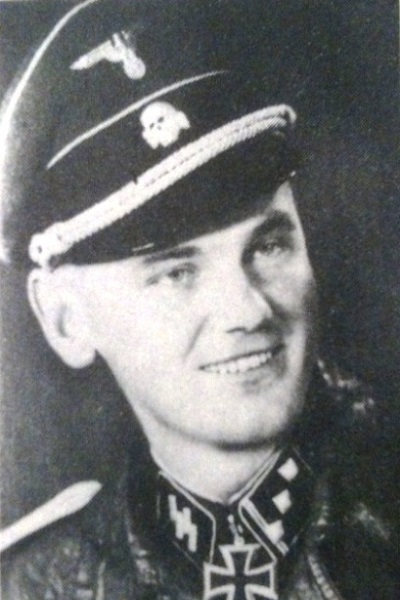Drexel, Hans Carl (Waffen SS)
- Date of birth:
- November 22nd, 1919 (Dettenhausen/Württemberg, Germany)
- Date of death:
- April 12th, 1962 (Stuttgart/Baden-Württemberg, Germany)
- Service number:
- SS-Nr.: 372.377 // NSDAP-Nr.:
- Nationality:
- German (1933-1945, Third Reich)
Biography
00.11.1938: entered the SS, SS-Infanterie-Standarte 'Deutschland', SS-VT
00.09.1939: campaign in Poland
00.05.1940: campaign in France
00.07.1940: SS-Junkerschule
00.11.1940: promoted to SS-Untersturmführer, Zugführer, 14. Kompanie, SS-Infanterie-Regiment 'Westland', SS-Division 'Wiking'
00.06.1941: Barbarossa
00.01.1942: promoted to SS-Obersturmführer
03.08.1943: SS-Ostuf, Führer, 10. Kompanie, SS-Panzergrenadier-Regiment 9 'Germania', 5. SS-Panzer-Division 'Wiking'
13.09.1943: Adjutant, II. Bataillon, SS-Panzergrenadier-Regiment 10 'Westland', 5. SS-Panzer-Division 'Wiking'
28.09.1943: destroyed a Russian attack at Boiki
09.11.1943: promoted to SS-Hauptsturmführer
00.01.1944: 5. SS-Freiwilligen-Sturmbrigade 'Wallonien' - Battle Korsun-Cherkassy Pocket
00.10.1944: severely WIA and sent to a Lazarett
Do you have more information about this person? Inform us!
- Period:
- Second World War (1939-1945)
- Rank:
- SS-Untersturmführer (2nd Lieutenant)
- Unit:
- Zugführer, 14. Kompanie, SS-Infanterie-Regiment 'Westland', SS-Division 'Wiking'
- Awarded on:
- August 7th, 1941
- Period:
- Second World War (1939-1945)
- Rank:
- SS-Untersturmführer (2nd Lieutenant)
- Awarded on:
- November 20th, 1941
- Period:
- Second World War (1939-1945)
- Rank:
- SS-Obersturmführer (Lieutenant)
- Awarded on:
- April 20th, 1942
- Period:
- Second World War (1939-1945)
- Rank:
- SS-Obersturmführer (Lieutenant)
- Awarded on:
- September 8th, 1942
- Period:
- Second World War (1939-1945)
- Rank:
- SS-Obersturmführer (Lieutenant)
- Awarded on:
- 1943
- Period:
- Second World War (1939-1945)
- Rank:
- SS-Obersturmführer (Lieutenant)
- Awarded on:
- 1943
- Period:
- Second World War (1939-1945)
- Awarded on:
- 1943
- Period:
- Second World War (1939-1945)
- Rank:
- SS-Obersturmführer (Lieutenant)
- Unit:
- Chef, 10. Kompanie, SS-Panzer-Grenadier-Regiment "Germania", 5. SS-Panzer-Division 'Wiking'
- Awarded on:
- August 3rd, 1943
- Period:
- Second World War (1939-1945)
- Rank:
- SS-Obersturmführer (Lieutenant)
- Unit:
- stellvertretender Führer, II. Bataillon, SS-Panzer-Grenadier-Regiment "Westland", 5. SS-Panzer-Division 'Wiking'
- Awarded on:
- October 14th, 1943
“During the hard defensive battles east of the Dnieper the enemy succeeded in taking the city of Chorol (north of Krementschug) and crossing the Chorol river, located to the northeast of the city. They sent in strong additional forces in order to thrust through to Krementschug via the shortest route.
On the 20.09.1943 the II./SS-Panzergrenadier-Regiment Westland under the command of SS-Obersturmführer Drexel was dispatched from the Poltava area. Its mission was to prevent an advance by the enemy southeast of Chorol.
After the reinforced II./SS-Panzergrenadier-Regiment Westland had reached Boiki it sent out armed reconnaissance units. These reported the presence of an assembly area containing strong enemy forces (including tanks) in the area Werbin Farm—Missaki—Mal. Popowka.
SS-Obersturmführer Drexel recognized the impending danger of an enemy thrust that might be unleashed at any moment. He therefore immediately assembled the available elements of his Bataillon and launched a swift and sudden attack on the enemy with the support of a few friendly Panzers and Batterien. In the process he himself thrust into the middle of the enemy at the head of his troops. He took full advantage of the confusion created among the enemy in the first moments of the attack, overran them with his men and threw them back towards the north. The losses of the enemy were very high. In addition to numerous small-arms the enemy also lost the following destroyed or captured:
18 anti-tank guns
1 artillery piece (12.5 cm)
1 light infantry gun
2 heavy mortars
4 medium mortars
4 anti-tank rifles
10 heavy machine-guns.
This bold attack launched on his own initiative put paid to all enemy intentions to attack on this day. Such an achievement in turn bought the necessary time to bring up additional friendly forces and establish a strong defensive front.
The swift and daring decision by SS-Obersturmführer Drexel prevented an enemy breakthrough towards Krementschug. This in turn prevented the Soviets from cutting off significant friendly elements from the Dnieper crossings.
The personal bravery and skillful, prudent leadership of SS-Obersturmführer Drexel is responsible for the total success of this surprise attack.
SS-Obersturmführer Drexel has participated in the Polish campaign and been involved in the campaign in the East since day one. He has already been awarded the German Cross in Gold for his repeated demonstrations of bravery. This energetic SS officer has accomplished a great deal in spite of his young age, and as such I hold him as worthy of being awarded the Knight’s Cross to the Iron Cross.”
Sources
- Photo 1: Igor Poul
- - MOONEY, PETER, Waffen-SS Knights and their Battles, Schiffer Publishing, Ltd., 2012.
- THOMAS, FRANZ & WEGMANN, GÜNTER, Die Ritterkreuzträger der Deutschen Wehrmacht 1939-1945, Biblio Verlag, Osnabrück, 2000.
- Die Ordensträger der Deutschen Wehrmacht (CD), VMD-Verlag GmbH, Osnabrück, 2002
- Patzwall K., Scherzer V., Das Deutsche Kreuz 1941-1945, Geschichte und Inhaber Band II, Verlag Klaus D. Patzwall, Norderstedt, 2001, ISBN 3-931533-45-X
- Die Träger des Ritterkreuzes des Eisernen Kreuzes 1939-1945
- Microfilm Publication A3343. US National Archives.










